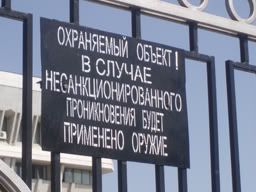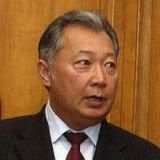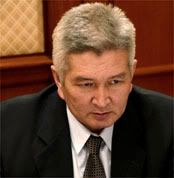I am happy to offer my readers a piece put together by David Hoffman who reports with suspicion from Pakistan about recent fighting in Waziristan between Pashtun tribal groups and the IMU. Having spent significant time in both Uzbekistan and Afghanistan, Dr. Hoffman gives us an interesting perspective on what may really be happening in Waziristan. I have added some hyperlinks to give the article a little more internet contextuality…enjoy!In its ten years of existence,
the Islamic Movement of Uzbekistan (IMU) has emerged as a force to reckon with – not in the military sense, but as a political “brand,” bandied about by a combination of sincere and cynical (but always self-interested) interests in the pursuit of ulterior motives. This effort has accelerated since 2001, with the rise of a veritable cottage industry promoting
the image of the IMU as an immediate, virile and offensive threat to stability in Central Asia and beyond. Vested interests in exaggerating the IMU threat abound in the corridor that runs from Massachusetts Ave in Washington to the Pentagon across the Potomac river: from contractors, consultants and think tanks fixated on the tsunami of post-9/11 security sector funding, to USG officials sincerely worried about the IMU’s role in global terror networks, to the Uzbek embassy’s ham-fisted attempts to justify its abysmal human rights record.
The “IMU” as a brand has flourished over the past seven years, generating revenues for intelligence consultants, career boosts for DOD officers, and a rhetorical crutch for the Uzbek government and its apologists. But is it a spent brand? The government of Pakistan, apparently, thinks not.
For those living in Pakistan, the past few weeks have been, in equal parts, exciting and disturbing. The country has been gripped with
a constitutional showdown between the President and Supreme Court Chief Justice, female madrassa vigilantes run amok the streets of the capital, and the humiliating ejection of the revered national cricket team from the World Cup. But perhaps no story has dominated the headlines as
the violence that has gripped South Waziristan, fighting that pits local tribesmen against – you guessed it – the IMU. Virtually every major Pakistani newspaper has been dominated over the past week by breathless headlines, detailing the fighting between “tribal volunteers” and “Uzbek militants.” A running tab of the week’s news articles puts the dead at over 250, with more than two-thirds of those Uzbeks loyal to
IMU leader Tahir Yuldashev. Wana is said to be rocked by heavy fighting, as Pashtun tribesmen push through artillery and small arms fire to root out Uzbeks from prepared firing positions and bunkers.
For analysts based in Central Asia, and in particular those with direct experience with the IMU and its predecessors, this explosion of IMU-related news may seem odd. This is because, by 2002, the IMU was already understood to be a spent force: small groups of bedraggled stragglers, foraging for food and shelter, were seen fleeing from the American aerial assault on northern Afghanistan in late 2001, after which verified sightings of the organization virtually ceased. Even at its height in 1999-2001, when the IMU flexed its muscle with several incursions from Tajikistan into Kyrgyzstan, firsthand accounts painted a picture of disorganized units with inadequate supply lines, almost no logistical coordination, and poor training, communications, and weaponry. Teenaged IMU fighters more concerned with staving off starvation than reestablishing the Caliphate provided a decidedly sober appraisal of the organization’s military abilities, and one – not surprisingly – at odds from the narrative proffered by some western think tanks and the Uzbek Foreign Ministry.
What remained of the IMU – some 300 “effectives,” plus approximately twice that number in women, children and various other “camp followers,” according to experts with on the ground experience with the IMU – was largely blasted out of existence under a hail of satellite-guided bombs in and around Kunduz and Balkh provinces in northern Afghanistan in November 2001. When the dust had settled from this opening salvo of Operation Enduring Freedom, DNA sampling was required to identify
what remained of Juma Namangani, the IMU’s military commander.
What remained of the Namangani’s organization is a slightly murkier affair. Following the IMU’s liquidation as a coherent fighting force, some of its remnants found refuge with certain Waziri sub-tribes inside Pakistan’s Federally Administered Tribal Areas. Pashtun tribes’ sense of honor
(Pashtunwali) is a well-documented phenomenon, especially insofar as treatment and protection of guests goes. It would thus be little surprise if IMU fighters, coming off a defeat in Afghanistan, were welcomed in Waziristan, where support for the Taliban is universal, regardless of Islamabad’s official proclamations. The five years that have passed since have witnessed few confirmed sightings of Uzbeks in Wana or any of the tribal agencies, and almost none in the jihadist battlefields of Afghanistan (literally next door, within walking distance of Wana) or Iraq.
Given the pitiful state of the IMU when it was last seen in active combat in 2002, and the organization’s ensuing silence, the fighting that has erupted in and around Wana has caught observers off-guard. According to the official version currently in vogue in the Pakistani press, “thousands” (the number has run as high as 10,000, but rarely drops below 2,000) of Uzbek militants are engaged in pitched battles with local Pashtun tribal militias. Even the normally staid Dawn newspaper dedicated not one but two headlines to the mini-war in a recent issue, declaring:
“The Game is Up for Uzbeks,” and “Dozens Killed as Tribesmen Attack Foreign Militants.” The stories circulating in the Pakistani media are mixed, but involve some combination of the following: heavy weaponry (frequent allusions to mortars, artillery shelling), heavy casualties (hundreds killed, and constant references to pitched battles, concrete bunkers and fortifications, etc.), and Uzbek militants depicted in the most nefarious of lights. One other common thread that has run through all of the Pakistani media accounts: all of them rely on government sources.
Unraveling the political dynamics involved in the South Waziristan fighting – the more basic questions of “Why this fighting, and why now?” – presents a rather more difficult challenge. Multiple, and not always consistent, theories are at play, including:
1. that this fighting reflects the successful implementation of the Pakistani government’s ongoing efforts to convince and compel Pashtun tribes to expel foreign militants operating in the Afghanistan-Pakistan border zone;
2. that it is a conflict between primarily foreign al Qaeda groups (and their local allies) and Taliban (and their local allies), or some combination thereof; and
3. that the fighting is the result of a social backlash against Uzbeks, consistent with rising local tensions (Pakistani sources have cited rumors of rape, extortion, assassination and other crimes supposedly committed by the Uzbeks against the local populace).
Clearly, the government of Pakistan has much to gain from the first hypothesis. Under siege, literally, from all sides – from
tongue lashings from Washington (most recently delivered, in person, by Dick Cheney), to a constitutional standoff between with the Supreme Court, to female madrassa students run amok in downtown Islamabad – Pakistan’s beleaguered President, Pervez Musharraf, has never been more in need of a public relations victory. And indeed, the narrative being spun by the Pakistani media, of a brave push by local Pashtun
lashkars to expel foreign militants from Pakistan, endeavors to deliver just that. It not only represents the seriousness with which Pakistan takes its role as a strategic American partner in the global war on terror, but it makes clear to Pakistani domestic audiences that this is an initiative being driven indigenously within the Pashtun tribal belt, without the imposition of federal forces . Coincidentally or not, this interpretation fells three birds with one stone for President Musharraf: Pakistan’s sagging reputation in Washington is given a boost, the government’s policy of co-opting local tribes and fighting by proxy is shown to be a success, and Pashtun tribesmen (whose relationship with the Pakistani state has been anything but simple in the past) are embraced by the flag of Pakistani nationalism as defending the country against foreign invaders.
It is a wonderful narrative – now only if it were true.
A closer examination of the facts on the ground cast serious doubt on the current narrative being promoted through the Pakistani media, and – by extension – the international press. The first thing to remember is that very few people know what is actually transpiring in FATA. No Pakistani journalists have ventured into South Waziristan since Din Mohammad – a local journalist - visited the area under the protection of local commander Maulvi Nazeer last month, and had four of his relatives assassinated as a result. Communications with the district – never reliable – have become exceedingly difficult as of late, as militants have cut the telephone lines into the area and destroyed the local telephone switch in Wana. Six telephone numbers remain operational in Wana, with all six running on special lines directly into the Pakistani military garrison based there.
Given the difficulty in reporting on the battle in South Waziristan, it is useful to critically examine the press reports thus far of the IMU operations there. Pakistani news outlets have, as noted, been detailing the battle based on secondhand reports from government sources. “Detailing,” that is, in every sense except providing actual details. For example, it is curious that the fighting, while richly reported in other respects (including not only casualty counts, but descriptions of which tribesmen suffered what types of wounds in encounters with the IMU), seems to lack any actual information that could identify Uzbeks in the IMU ranks. Besides the public figure of IMU leader Tahir Yoldashev, not a single Uzbek involved in the Wana fighting has been named in any Pakistani news articles. Local tribesmen opposing the IMU are described in detail, but the Uzbeks who have presumably lived in some degree of harmony in the local communities for five or more years remain a faceless group.
Moreover, two separate sources insides Waziristan have confirmed that, in fact, they have not actually seen any actual Uzbeks, live or dead, during this latest conflagration. In battles whose casualty figures speak to its intensity, scale and duration, conventional military wisdom holds that hundreds of dead should be matched by several times as many wounded. Again, curiously – local hospitals and clinics have been unable to report the presence of large numbers of Uzbeks admitted for care. And while the press has dutifully reported dozens of captured IMU fighters, these prisoners have failed thus far to materialize. One local tribal leader, when asked about IMU fighters his men had captured, could not explain their absence, and then claimed that his men had “transferred [the Uzbeks] to the local jirga (council).” Given the public relations treasure trove captured foreign fighters would represent to a Pakistani government still stinging from accusations by Washington that it needs to “do more” in the fight against terrorism, it is hard to understand the government’s failure to produce the IMU prisoners, in order to milk them for their propaganda value. Similarly, the lack of any statements by Yoldashev (or any IMU commanders for that matter) to explain their position, rally support, or appeal to comrades-in-arms raises eyebrows, given that the organization, we are told, is involved in perhaps its climactic battle for existence. Instead, even sympathetic outlets such as the Urdu Daily Jasarat and media affiliated with the Taliban, have not been able to deliver the IMU’s standpoint.
Finally, it is difficult to reconcile the evidence at hand with Pakistani press reporting of the IMU’s order of battle. Simply, the numbers just don’t add-up: barring a spectacular burst of recruiting, it would be difficult to imagine how an organization that numbered, at most, in the hundreds has, after suffering a crushing defeat and dangerous passage into remote exile in 2002, managed to blossom into an organization capable of fielding a fighting force several thousand strong in Pakistan five years later. Furthermore, mounting operations of the sort alluded to in the Pakistani press would require not only stores of heavy weapons, ammunition and supplies, but communications, logistics and a training regimen to keep the IMU battle-ready. The IMU’s absence from the nearby battlefields in southeastern Afghanistan these past few years, therefore, raises questions how, from a tactical standpoint, it could reconstitute itself into a coherent fighting force replete with heavy weapons and prepared positions, in such a short time.
In short, while the Pakistani press continues to produce an enormous amount of front-page coverage on the situation in Wana, it is far from clear what exactly is being reported. No hard evidence has emerged to point to the presence of actual Uzbek IMU fighters in the recent fighting. Pakistani media accounts of the fighting have been incestuous and uncorroborated, and trace back to the same small number of government sources of questionable reliability. And inside Waziristan itself, no one thus far has been able to produce any actual Uzbeks – live or dead – to tell the “IMU’s” side of the story. Given the very substantial vested in interests in having a foreign boogeyman to blame for the violence plaguing Pakistan’s lawless FATA region, it may be the case that the IMU brand has been dusted off for one more marketing campaign.


















